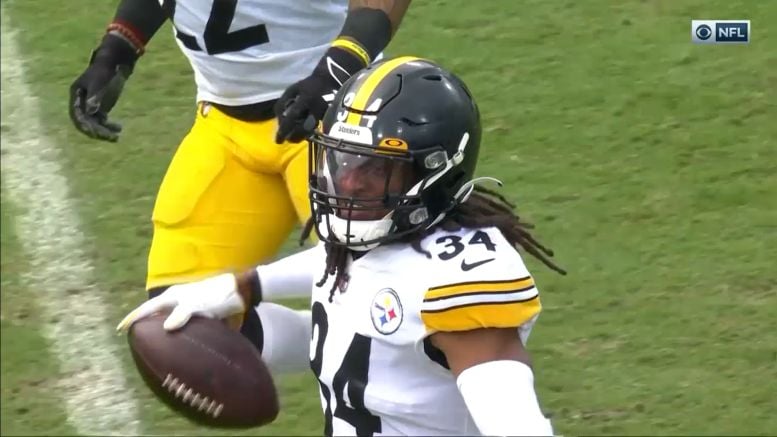One of the most common things you hear after every draft is that grades can’t be finished until at least three years after a pick has been made. So after submitting my grades for every Steelers’ pick in this year’s class, I’m going back and revisiting picks from three years ago and beyond made by Pittsburgh. That starts today with the team’s first-round pick in 2018, safety Terrell Edmunds out of Virginia Tech.
I tweaked my exercise for grading this year’s draft to look at and give letter grades to past picks, based on five specific ways to view the pick (listed below), before taking all that analysis and combining it into a final letter grade. Those five viewpoints comprise much of what goes into the draft grades consumed by so many every year after the draft.
Steelers’ Career: What did the player contribute to the team that drafted him?
NFL Career: Did the player make the pick look better in hindsight after leaving Pittsburgh?
Pick Value: Did the player outperform his draft slot? Did he fail to live up to the pick used on him?
Positional Value: Was the player the best player remaining at his specific position in the draft?
Other Options: Did any players go during the next round that were better selections?
Overall Grade: A final mark to denote whether the selection was an overall positive one, or one that could’ve been better spent elsewhere.
Just like when grading a current year’s draft, each factor in a retrospective doesn’t apply evenly to every pick made. For example, a first round selection should have a longer and more impactful career, whereas a late-round pick only needs a few seasons in a limited role to live up to his draft slot.
Some factors are universal, though. Whether picked first overall or 259th, there will always be other options on the board to compare the player to, and steals and reaches can come from any place in the draft.
Round 1, Pick 28: Terrell Edmunds, S, Virginia Tech
STEELERS & NFL CAREER: B-
Trending toward “bust” status early in his career, Edmunds has continually improved while serving as a full-time starter every season. In three years, he has been a starter in 44 of the Steelers’ 48 games. In his career, Edmunds has picked off three interceptions, defensed 16 passes, recorded 257 tackles (five for a loss), and recovered one fumble. His numbers peaked in 2019, with 105 tackles, and in 2020, with two interceptions and eight passes defensed.
Edmunds has never been a Pro Bowler or tremendously close to being one. He has been a consistent presence on the back line of the team’s defense, most notably next to Minkah Fitzpatrick. That comes with strengths, such as a developing role playing closer to the line while Fitzpatrick handles coverage. It also comes with weaknesses; even after three seasons, Edmunds remains more of a liability in coverage than an asset, and gets beat in zone and man. Those continued deficiencies in coverage are tough to stomach for a starting defensive back entering his fourth season. His ability to retain the starting job and improve every year though (coverage included) earn him a positive grade, though.
PICK VALUE: C-
The selection of Edmunds was viewed as a reach and one of the worst picks of the first round when it happened. It is far from the latter three years later. But it does remain a reach. A first-round safety needs to have the impact of Edmunds’ teammate, Fitzpatrick. And if not that, at least be close to it. With his year-by-year improvements, Edmunds has begun to help his case. But he is far closer to “solid yet unspectacular” as a starter than “first-round star”. It’s going to take his biggest step forward yet this season to live up to the value of a top 32 pick.
POSITIONAL VALUE: B+
This wasn’t a tremendous class for defensive backs by this point in the draft. You have to go down to the 23rd pick in the second round (Carolina corner Donte Jackson) to find a slam-dunk better DB then Edmunds. Surveying the rest of the class, there are only two other options who stand out as clearly better choices. One is Tampa Bay’s Carlton Davis, a corner taken 31st in the second round.
The other is the big whiff at the position: Jessie Bates III, then of Wake Forest and now a defensive superstar for the rival Cincinnati Bengals. Like Edmunds, Bates was viewed as a Day 2 pick in the class. But he has emerged as a true top-tier safety in the NFL, earning All-Pro honors this season. That brings down the grade a bit, but the rest of the safety class is no competition for he and Edmunds. Compared to other 2018 safeties, Edmunds is a home run of a pick.
OTHER OPTIONS: B
I’ll address the biggest name selected over the next 32 picks: Yes, Lamar Jackson went four picks after Edmunds. But his success came as Baltimore revamped its offense to suit his game. One, I’m not sure Pittsburgh would have done that, and two, the team wasn’t in a crisis to find an immediate replacement for Ben Roethlisberger as it is now.
There is plenty of other talent that went between that pick and Pittsburgh’s second-rounder. Nick Chubb is tearing it up in Cleveland’s backfield. Darius Leonard is one of the best linebackers in football for Indianapolis. Braden Smith is with him there as a solid player on the Colts’ O-Line. Tight ends Mike Gesicki (Miami) and Dallas Goedert (Philadelphia) went in the middle second. Then there is Jackson in Carolina.
At the time, Pittsburgh had minimal needs. Safety was the runaway leader among them, though inside linebacker was also up there following the tragic injury to Ryan Shazier. That leaves Bates and Leonard as the ones that hurt the most to have missed out on at that point. It stings, but for a first-round pick, there could be far more regret with the group of names to get away.
OVERALL GRADE: B-
From where he was as a rookie to where he enters the 2021 season, Edmunds has improved considerably. That is his biggest asset when viewing this pick in retrospect. He has found a home as a starter in the team’s defense, though there is plenty of room to grow in it. Pittsburgh may have correctly declined his fifth-year option, but an extension for a lesser amount is still very much in play depending on the 2021 season.
Missing out on Bates, Jackson, and Leonard hurts, and nothing will change the fact that Edmunds was a mid or late second-rounder who the team reached on in the first. But Edmunds has shed the bust label, and will only get it back in full if he regresses and is allowed to depart freely this offseason. Losing that stigma is one major step. The other is taking his biggest step forward in 2021, particularly becoming more reliable in coverage, and proving he is a long-term complement to Fitzpatrick at safety. If he does, he can prove to be the rare safety worth a first-rounder, and his grade in retrospect will climb even further.






